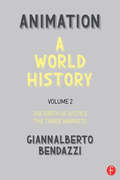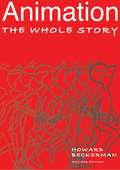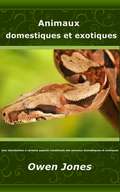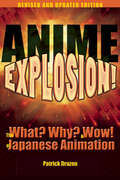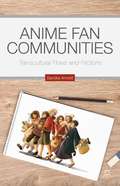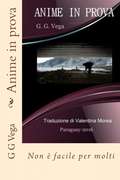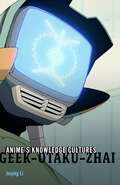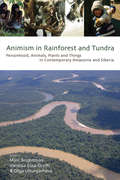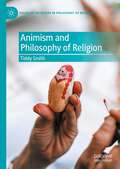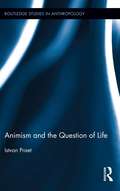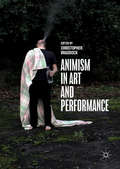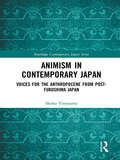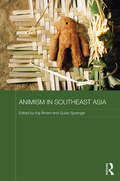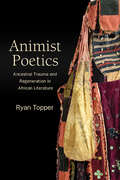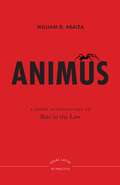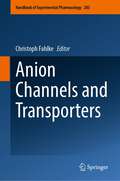- Table View
- List View
Animation: The Birth of a Style - The Three Markets
by Giannalberto BendazziA continuation of 1994's groundbreaking Cartoons, Giannalberto Bendazzi's Animation: A World History is the largest, deepest, most comprehensive text of its kind, based on the idea that animation is an art form that deserves its own place in scholarship. Bendazzi delves beyond just Disney, offering readers glimpses into the animation of Russia, Africa, Latin America, and other often-neglected areas and introducing over fifty previously undiscovered artists. Full of first-hand, never before investigated, and elsewhere unavailable information, Animation: A World History encompasses the history of animation production on every continent over the span of three centuries. Volume II delves into the decades following the Golden Age, an uncertain time when television series were overshadowing feature films, art was heavily influenced by the Cold War, and new technologies began to emerge that threatened the traditional methods of animation. Take part in the turmoil of the 1950s through 90s as American animation began to lose its momentum and the advent of television created a global interest in the art form. With a wealth of new research, hundreds of photographs and film stills, and an easy-to-navigate organization, this book is essential reading for all serious students of animation history.
Animation: The Whole Story
by Howard BeckermanProfessional animator Howard Beckerman has drawn them all: Popeye, Heckle & Jeckle, even Mickey Mouse. In Animation, he offers a road map to the complex art of making an animated feature. Vivid sketches, screen shots, and step-by-step illustrations show how to make a drawing come to life, create storyboards, use form and color, develop a soundtrack, edit, and more. This new edition is also thoroughly updated to reflect the latest trends surrounding digital technology. Animation provides artists and aspiring filmmakers with everything they need to carve their niche in today's quickly evolving animation industry.
Animator (Cool Cutting Edge Careers)
by Jessica CohnIf you've seen a movie made with computer graphics, played one of the latest video games, or even just watched cartoons on a Saturday morning, then you've seen what animators do. Learn all about how animators work to create the movies, games, and TV shows that you love. Hear from the animators themselves about what it takes to make it in this exciting career.
Animaux domestiques et exotiques: Une introduction à certains aspects inhabituels des animaux domestiques et exotiques (Comment faire... #31)
by Owen JonesAnimaux domestiques et exotiques Une introduction à certains aspects inhabituels des animaux domestiques et exotiques J'espère que vous trouverez les informations serviables, utiles et profitables. Les informations contenues dans cet ebook sur divers aspects des animaux exotiques et autres sont organisées en 19 chapitres d'environ 500 à 600 mots chacun. J'espère que cela intéressera ceux qui aiment les animaux. Comme bonus, je vous autorise à utiliser le contenu sur votre propre site Web ou dans vos propres blogs et newsletter, bien qu'il soit préférable de les réécrire d'abord dans vos propres mots. Vous pouvez également diviser le livre et revendre les articles. En fait, le seul droit que vous n'avez pas est de revendre ou de donner le livre tel qu'il vous a été livré.
Anime Classics Zettai!
by Brian Camp Julie DavisFrom Stone Bridge Press, award-winning publishers of The Anime Encyclopedia, Hayao Miyazaki, and The Astro Boy Essays, comes a must-have guide to 100 essential Japanese animation films, TV series, and made-for-video series, from 1950s classics to the latest Cartoon Network hits.Looking for something specific? Eight unique icons make reviews easy to browse. From Akira to Naruto, Pokemon to Sailor Moon, here are summaries, style notes, rare facts, viewer-discretion guides, and critical comments on films that fans absolutely-zettai!-must see. Note: due to rights restrictions the ebook edition does not include images that are in the print edition.Julie Davis is the former editor-in-chief of Animerica: Anime & Manga Monthly. A writer and editor in San Francisco, Davis has translated manga for Viz (now Viz Media) and has contributed to Otaku USA and Manga: The Complete Guide.Brian Camp, program manager at CUNY-TV in New York, was a regular contributor to Animerica: Anime & Manga Monthly, and has taught a course on anime at New York's School of Visual Arts. Camp has also contributed to Animation World, Film Library Quarterly, the Motion Picture Guide, and the New York Daily News.
Anime Explosion!
by Patrick DrazenAn updated look at Japanese animation, and the manga that inspired them. New chapters on "Fullmetal Alchemist," manga/anime by CLAMP, and Satoshi Kon. It brings fans up to date on Studio Ghibli movies after the Academy Award-winning "Spirited Away," new titles like "Negima" and "Ouran High School Host Club," and breakthrough same-sex stories "Gravitation" and "Mother Mary is Watching."
Anime Fan Communities
by Sandra AnnettHow have animation fans in Japan, South Korea, the United States, and Canada formed communities and dealt with conflicts across cultural and geographic distance? This book traces animation fandom from its roots in early cinema audiences, through mid-century children's cartoon fan clubs, to today's digitally-networked transcultural fan cultures.
Anime Impact: The Movies and Shows that Changed the World of Japanese Animation
by Chris StuckmannAn exploration of anime’s masterpieces and game-changers from the 1960s to the present—with contributions from writers, artists, superfans and more.Anime—or Japanese animation—has been popular in Japan since Astro Boy appeared in 1963. Subsequent titles like Speed Racer and Kimba the White Lion helped spread the fandom across the country. In America, a dedicated underground fandom grew through the 80s and 90s, with breakthrough titles like Katsuhiro Otomo’s Akira making their way into the mainstream.Anime Impact explores the iconic anime movies and shows that left a mark on popular culture around the world. Film critic and longtime fan Chris Stuckmann takes readers behind the scenes of legendary titles as well as hidden gems rarely seen outside Japan. Plus anime creators, critics and enthusiasts—including Ready Player One author Ernest Cline, manga artist Mark Crilley, and YouTube star Tristan “Arkada” Gallant—share their stories, insights and insider perspectives.
Anime and Philosophy
by Tristan D. Tamplin Josef SteiffAnime and Philosophy focuses on some of the most-loved, most-intriguing anime films and series, as well as lesser-known works, to find what lies at their core. Astro Boy, Dragon Ball Z, Ghost in the Shell, and Spirited Away are just a few of the films analyzed in this book. In these stories about monsters, robots, children, and spirits who grapple with the important questions in life we find insight crucial to our times: lessons on morality, justice, and heroism, as well as meditations on identity, the soul, and the meaning - or meaninglessness - of life. Anime has become a worldwide phenomenon, reaching across genres, mediums, and cultures. For those wondering why so many people love anime or for die-hard fans who want to know more, Anime and Philosophy provides a deeper appreciation of the art and storytelling of this distinctive Japanese culture.
Anime from Akira to Howl's Moving Castle: Experiencing Contemporary Japanese Animation
by Susan J. NapierJapanese animation is more popular than ever following the 2002 Academy Award given to Hayao Miyazaki's Spirited Away. It confirmed that anime is more than just children's cartoons, often portraying important social and cultural themes. With new chapters on Spirited Away and other recent releases, including Howl's Moving Castle-- which broke records in Japan--this edition will be the authoritative source on anime for an exploding market of viewers who want to know more.
Anime in prova
by Guido Galeano Vega Valentina MoreaIl libro Anime in prova è ispirato alla realtà che soffrono ogni giorno persone disagiate per le strade, sotto i ponti, vivendo come o peggio dei cani, mentre attorno esistono persone che avendo un eccesso di risorse, che potrebbero tender loro la mano, alzarli e aiutarli a rimettere in piedi le proprie vite, semplicemente li disprezza e li ignora. Nessuno sceglierebbe questo tipo di esperienza per se stesso, se si trovano li è perché le loro vite non sono state facili. Il proposito del libro è risvegliare la compassione che ogni essere umano possiede e deve possedere nella sua anima verso i propri simili caduti in disgrazia.
Anime's Identity: Performativity and Form beyond Japan
by Stevie SuanA formal approach to anime rethinks globalization and transnationality under neoliberalism Anime has become synonymous with Japanese culture, but its global reach raises a perplexing question—what happens when anime is produced outside of Japan? Who actually makes anime, and how can this help us rethink notions of cultural production? In Anime&’s Identity, Stevie Suan examines how anime&’s recognizable media-form—no matter where it is produced—reflects the problematics of globalization. The result is an incisive look at not only anime but also the tensions of transnationality.Far from valorizing the individualistic &“originality&” so often touted in national creative industries, anime reveals an alternate type of creativity based in repetition and variation. In exploring this alternative creativity and its accompanying aesthetics, Suan examines anime from fresh angles, including considerations of how anime operates like a brand of media, the intricacies of anime production occurring across national borders, inquiries into the selfhood involved in anime&’s character acting, and analyses of various anime works that present differing modes of transnationality. Anime&’s Identity deftly merges theories from media studies and performance studies, introducing innovative formal concepts that connect anime to questions of dislocation on a global scale, creating a transformative new lens for analyzing popular media.
Anime's Knowledge Cultures: Geek, Otaku, Zhai
by Jinying LiUnlocking the technosocial implications of global geek cultures Why has anime, a &“low-tech&” medium from last century, suddenly become the cultural &“new cool&” in the information age? Through the lens of anime and its transnational fandom, Jinying Li explores the meanings and logics of &“geekdom&” as one of the most significant sociocultural groups of our time. In Anime&’s Knowledge Cultures, Li shifts the center of global geography in knowledge culture from the computer boys in Silicon Valley to the anime fandom in East Asia. Drawing from film studies, animation studies, media theories, fan studies, and area studies, she provides broad cultural and theoretical explanations of anime&’s appeal to a new body of tech-savvy knowledge workers and consumers commonly known as geeks, otaku, or zhai. Examining the forms, techniques, and aesthetics of anime, as well as the organization, practices, and sensibilities of its fandom, Anime&’s Knowledge Cultures is at once a theorization of anime as a media environment as well as a historical and cultural study of transnational geekdom as a knowledge culture. Li analyzes anime culture beyond the national and subcultural frameworks of Japan or Japanese otaku, instead theorizing anime&’s transnational, transmedial network as the epitome of the postindustrial knowledge culture of global geekdom. By interrogating the connection between the anime boom and global geekdom, Li reshapes how we understand the meanings and significance of anime culture in relation to changing social and technological environments.
Anime’s Media Mix: Franchising Toys and Characters in Japan
by Marc SteinbergIn Anime&’s Media Mix, Marc Steinberg convincingly shows that anime is far more than a style of Japanese animation. Beyond its immediate form of cartooning, anime is also a unique mode of cultural production and consumption that led to the phenomenon that is today called &“media mix&” in Japan and &“convergence&” in the West. According to Steinberg, both anime and the media mix were ignited on January 1, 1963, when Astro Boy hit Japanese TV screens for the first time. Sponsored by a chocolate manufacturer with savvy marketing skills, Astro Boy quickly became a cultural icon in Japan. He was the poster boy (or, in his case, &“sticker boy&”) both for Meiji Seika&’s chocolates and for what could happen when a goggle-eyed cartoon child fell into the eager clutches of creative marketers. It was only a short step, Steinberg makes clear, from Astro Boy to Pokémon and beyond.Steinberg traces the cultural genealogy that spawned Astro Boy to the transformations of Japanese media culture that followed—and forward to the even more profound developments in global capitalism supported by the circulation of characters like Doraemon, Hello Kitty, and Suzumiya Haruhi. He details how convergence was sparked by anime, with its astoundingly broad merchandising of images and its franchising across media and commodities. He also explains, for the first time, how the rise of anime cannot be understood properly—historically, economically, and culturally—without grasping the integral role that the media mix played from the start. Engaging with film, animation, and media studies, as well as analyses of consumer culture and theories of capitalism, Steinberg offers the first sustained study of the Japanese mode of convergence that informs global media practices to this day.
Animism In Rainforest And Tundra
by Vanessa Elisa Grotti Marc Brightman Olga UlturgashevaAmazonia and Siberia, classic regions of shamanism, have long challenged 'western' understandings of man's place in the world. By exploring the social relations between humans and non-human entities credited with human-like personhood (not only animals and plants, but also 'things' such as artifacts, trade items, or mineral resources) from a comparative perspective, this volume offers valuable insights into the constitutions of humanity and personhood characteristic of the two areas. The contributors conducted their ethnographic fieldwork among peoples undergoing transformative processes of their lived environments, such as the depletion of natural resources and migration to urban centers. They describe here fundamental relational modes that are being tested in the face of change, presenting groundbreaking research on personhood and agency in shamanic societies and contributing to our global understanding of social and cultural change and continuity.
Animism and Philosophy of Religion (Palgrave Frontiers in Philosophy of Religion)
by Tiddy SmithMainstream philosophy of religion has persistently failed to engage seriously or critically with animist beliefs and practices. The field that is now called "philosophy of religion" could quite easily be renamed "philosophy of theism" with few lecturers on the subject having to change their lecture notes. It is the aim of this volume to rectify that failure and to present animism as a live option among the plethora of religious worldviews. The volume addresses four major questions: 1. What is this thing called "animism"? 2. Are there any arguments for or against animist belief and practice? 3. What is the relationship between animism, naturalism, and the sciences? And 4. Should we take animism seriously? Animism and Philosophy of Religion is intended to be the first authoritative scholarly volume on the issue of animism and its place in the philosophy of religion. Ambitiously, it aims to act as the cornerstone volume for future work on the subject and as a key text for courses engaging with the subject.
Animism and the Question of Life: Animism And The Question Of Life (Routledge Studies in Anthropology)
by Istvan PraetThe central purpose of this book is to help change the terms of the debate on animism, a classic theme in anthropology. It combines some of the finest ethnographic material currently available (including firsthand research on the Chachi of Ecuador) with an unusually broad geographic scope (the Americas, Asia, and Africa). Edward B. Tylor originally defined animism as the first phase in the development of religion. The heyday of cultural evolutionism may be over, but his basic conception is commonly assumed to remain valid in at least one respect: there is still a broad consensus that everything is alive within animism, or at least that more things are alive than a modern scientific observer would allow for (e.g., clouds, rivers, mountains) It is considered self-evident that animism is based on a kind of exaggeration: its adherents are presumed to impute life to this, that and the other in a remarkably generous manner. Against the prevailing consensus, this book argues that if animism has one outstanding feature, it is its peculiar restrictiveness. Animistic notions of life are astonishingly uniform across the globe, insofar as they are restricted rather than exaggerated. In the modern Western cosmology, life overlaps with the animate. Within animism, however, life is always conditional, and therefore tends to be limited to one’s kin, one’s pets and perhaps the plants in one’s garden. Thus it emerges that "our" modern biological concept of life is stranger than generally thought.
Animism beyond the Soul: Ontology, Reflexivity, and the Making of Anthropological Knowledge (Studies in Social Analysis #6)
by Katherine Swancutt Mireille MazardHow might we envision animism through the lens of the ‘anthropology of anthropology’? The contributors to this volume offer compelling case studies that demonstrate how indigenous animistic practices, concepts, traditions, and ontologies are co-authored in highly reflexive ways by anthropologists and their interlocutors. They explore how native epistemologies, which inform anthropological notions during fieldwork, underpin the dialogues between researchers and their participants. In doing so, the contributors reveal ways in which indigenous thinkers might be influenced by anthropological concepts of the soul and, equally, how they might subtly or dramatically then transform those same concepts within anthropological theory.
Animism in Art and Performance
by Christopher BraddockThis book explores Māori indigenous and non-indigenous scholarship corresponding with the term ‘animism’. In addressing visual, media and performance art, it explores the dualisms of people and things, as well as 'who' or 'what' is credited with 'animacy'. It comprises a diverse array of essays divided into four sections: Indigenous Animacies, Atmospheric Animations, Animacy Hierarchies and Sensational Animisms. Cassandra Barnett discusses artists Terri Te Tau and Bridget Reweti and how personhood and hau (life breath) traverse art-taonga. Artist Natalie Robertson addresses kōrero (talk) with ancestors through photography. Janine Randerson and sound artist Rachel Shearer consider the sun as animate with mauri (life force), while Anna Gibb explores life in the algorithm. Rebecca Schneider and Amelia Jones discuss animacy in queered and raced formations. Stephen Zepke explores Deleuze and Guattari's animist hylozoism and Amelia Barikin examines a mineral ontology of art. This book will appeal to readers interested in indigenous and non-indigenous entanglements and those who seek different approaches to new materialism, the post-human and the anthropocene.
Animism in Contemporary Japan: Voices for the Anthropocene from post-Fukushima Japan (Routledge Contemporary Japan Series)
by Shoko Yoneyama‘Postmodern animism’ first emerged in grassroots Japan in the aftermath of mercury poisoning in Minamata and the nuclear meltdown in Fukushima. Fusing critiques of modernity with intangible cultural heritages, it represents a philosophy of the life-world, where nature is a manifestation of a dynamic life force where all life is interconnected. This new animism, it is argued, could inspire a fundamental rethink of the human-nature relationship. The book explores this notion of animism through the lens of four prominent figures in Japan: animation film director Miyazaki Hayao, sociologist Tsurumi Kazuko, writer Ishimure Michiko, and Minamata fisherman-philosopher Ogata Masato. Taking a biographical approach, it illustrates how these individuals moved towards the conclusion that animism can help humanity survive modernity. It contributes to the Anthropocene discourse from a transcultural and transdisciplinary perspective, thus addressing themes of nature and spirituality, whilst also engaging with arguments from mainstream social sciences. Presenting a new perspective for a post-anthropocentric paradigm, Animism in Contemporary Japan will be useful to students and scholars of sociology, anthropology, philosophy and Japanese Studies.
Animism in Southeast Asia (Routledge Contemporary Southeast Asia Series)
by Guido Sprenger Kaj ArhemAnimism refers to ontologies or worldviews which assign agency and personhood to human and non-human beings alike. Recent years have seen a revival of this concept in anthropology, where it is now discussed as an alternative to modern-Western naturalistic notions of human-environment relations. Based on original fieldwork, this book presents a number of case studies of animism from insular and peninsular Southeast Asia and offers a comprehensive overview of the phenomenon - its diversity and underlying commonalities and its resilience in the face of powerful forces of change. Critically engaging with the current standard notion of animism, based on hunter-gatherer and horticulturalist societies in other regions, it examines the roles of life forces, souls and spirits in local cosmologies and indigenous religion. It proposes an expansion of the concept to societies featuring mixed farming, sacrifice and hierarchy and explores the question of how non-human agents are created through acts of attention and communication, touching upon the relationship between animist ontologies, world religion, and the state. Shedding new light on Southeast Asian religious ethnographic research, the book is a significant contribution to anthropological theory and the revitalization of the concept of animism in the humanities and social sciences.
Animist Poetics: Ancestral Trauma and Regeneration in African Literature (SUNY series, Philosophy and Race)
by Ryan TopperArgues that African literature conceptualizes trauma and regeneration as a more-than-human process, offering an animist revision of psychoanalysis.Psychoanalytic trauma theory largely disregards African perspectives. Postcolonial criticism often filters these perspectives through a secular humanist lens. Examining how African literature uses animism to address the traumas of colonization, Animist Poetics offers a new understanding of the postcolonial condition. From an animist viewpoint, the self is not an individual but rather a regenerative process linking the living, the dead, and their ecosystems. Looking at poetry, fiction, drama, and visual art—including archival manuscripts by Wole Soyinka and Yvonne Vera—Ryan Topper argues that African literature reinvents these Indigenous ecologies in uniquely modern ways. Animist Poetics takes Indigenous—and literary—knowledge seriously, rethinking the foundations of psychoanalysis and charting new theoretical paths in posthumanism, the environmental humanities, new materialism, biopolitics, and memory studies.
Animus, Psyche and Culture: A Jungian Revision
by Sulagna SenguptaAnimus, Psyche and Culture takes Carl Jung’s concept of contra-sexual psyche and locates it within the cultural expanse of India, using ethnographic narratives, history, religion, myth, films, biographical extracts to deliberate on the feminine in psychological, social and archetypal realms. Jung’s concept of unconscious contra-sexuality, based on notions of feminine Eros and masculine Logos, was pioneering in his time, but took masculine and feminine to be fixed and essential attributes of gender in the psyche. This book explores the relevance of the animus, examining its rationale in current contexts of gender fluidity. Taking off from Post Jungian critiques, it proposes an exposition of the animus in history, social and religious phenomena, theories of knowledge, psychoid archetype and synchronicity, to grasp its nuances in diverse cultural worlds. This study re-envisions the notion of animus keeping in mind the intricacies of feminine subjectivity and the diversity of cultural worlds where depth psychological ideas are currently emerging. A remarkable reworking of Jungian ideas, this well-researched and important new book will be an insightful read for Jungian analysts and scholars with an interest in cultural and gender studies.
Animus: A Short Introduction to Bias in the Law
by William D. AraizaAn introduction to the legal concept of unconstitutional bias.If a town council denies a zoning permit for a group home for intellectually disabled persons because residents don’t want “those kinds of people” in the neighborhood, the town’s decision is motivated by the public’s dislike of a particular group. Constitutional law calls this rationale “animus.”Over the last two decades, the Supreme Court has increasingly turned to the concept of animus to explain why some instances of discrimination are unconstitutional. However, the Court’s condemnation of animus fails to address some serious questions. How can animus on the part of people and institutions be uncovered? Does mere opposition to a particular group’s equality claims constitute animus? Does the concept of animus have roots in the Constitution?Animus engages these important questions, offering an original and provocative introduction to this type of unconstitutional bias. William Araiza analyzes some of the modern Supreme Court’s most important discrimination cases through the lens of animus, tracing the concept from nineteenth century legal doctrine to today’s landmark cases, including Obergefell vs. Hodges and United States v. Windsor, both related to the legal rights of same-sex couples. Animus humanizes what might otherwise be an abstract legal question, illustrating what constitutes animus, and why the prohibition against it matters more today than ever in our pluralistic society.
Anion Channels and Transporters (Handbook of Experimental Pharmacology #283)
by Christoph FahlkeThis book provides an overview on recent progress in anion channels and transporters. It covers multiple scales of analysis ranging from studying the molecular basis of function at atomic resolution to cellular consequences to channel/transporter dysfunction and approaches to correct such processes by pharmacological intervention. Similar anion channels and transporters are expressed in multiple tissues – often fulfilling similar cellular tasks, but also clearly distinct functions. The aim is to combine work on multiple cell and organ systems.
